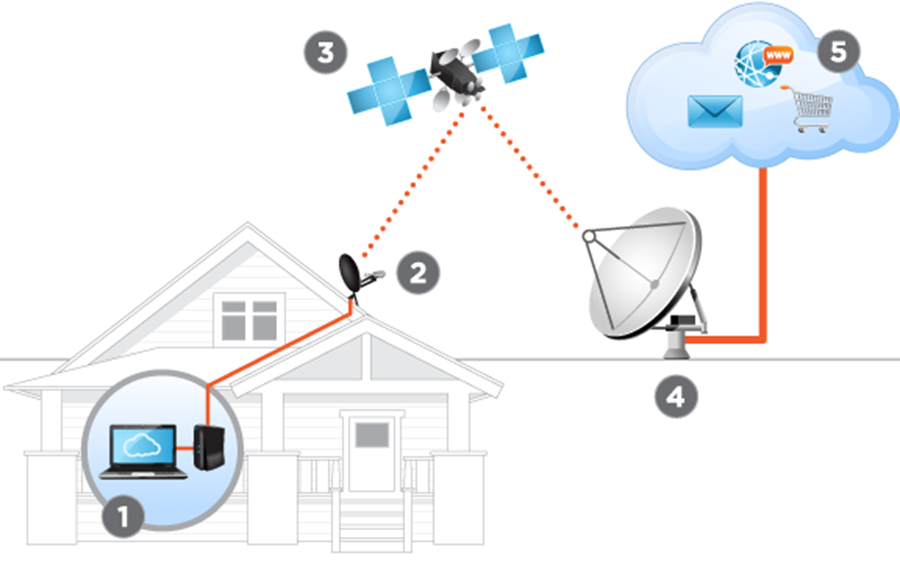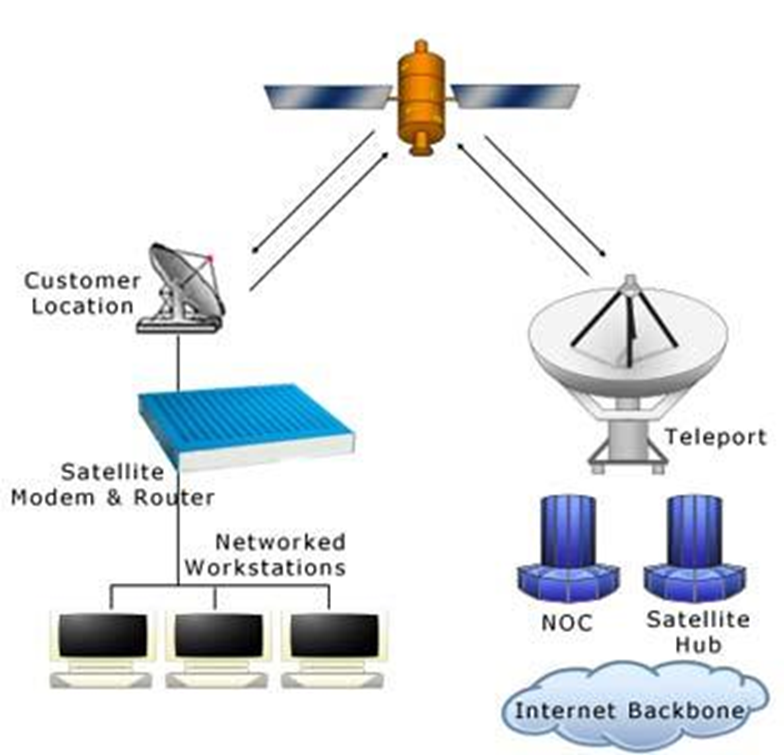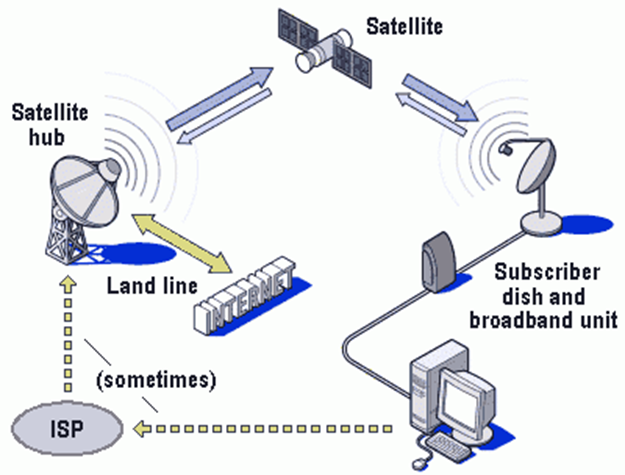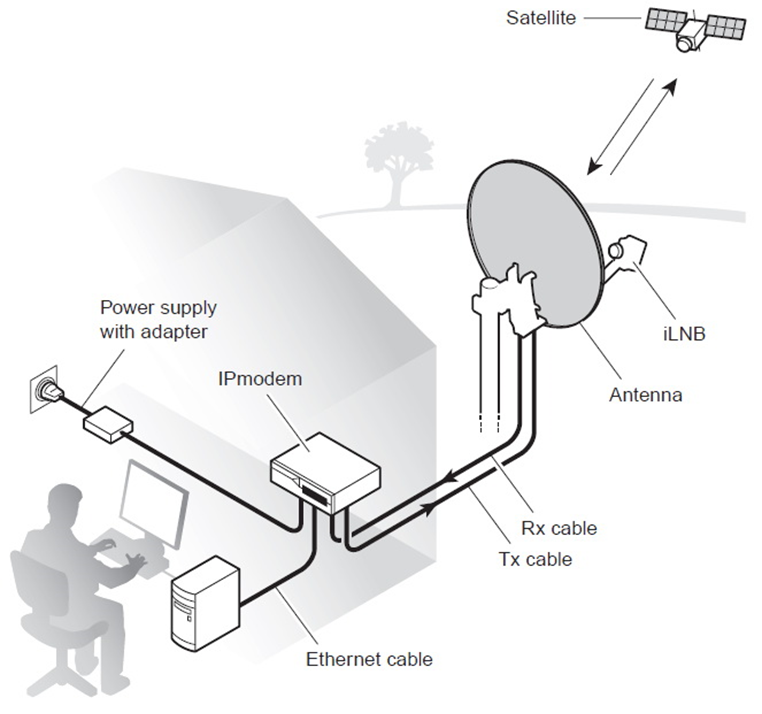Broadband Satellite Internet
There are numerous technologies, applications and topologies for satellite Internet, such:
--With regards to satellite technologies, we have geostationary orbiting, low orbiting satellites, and satellites operating at different frequencies
--As far as topologies are concerned, we have hub systems, star systems and other sophisticated systems on the ground, and finally
--There are numerous different application circumstances which require different complexities of technologies such as military grade, governmental use, commercial and enterprise use, business and professional as well as residential applications, all require their own technologies and configurations.
Satellites have brought Internet access to places where IP communications seemed impossible. In this section, we explain how satellite Internet works. You will understand how bytes of information or simply a mouse click travels all the way from your computer to the satellite, to the Internet and back. VSAT Systems uses commercial satellite connections as a high-speed digital link between the customers and the Internet backbone. The main components of a satellite system comprises of the following:

1 Ground-based electronic equipment
The indoor modem connected to your computer: A satellite modem facilitates data transfers using a communications satellite as a relay.
The satellite Internet modem supplied is connected directly to your laptop or PC with an
Ethernet cable. Another option that you have is to purchase
a wireless router and connect it to your modem. This lets you create an in-home network that
will let you connect various Internet-enabled devices, such as computers, smartphones,
gaming consoles and tablets to the Internet service.
A satellite dish – usually installed outdoors, often on top of your roof
The satellite dish that gets installed receives and transmits signals with the internet provider's
satellite. It is approximately the same size as most dishes used for satellite TV. The small
satellite dish can be mounted in various locations such as on your roof, on a pole or on
the side of your home. VSAT units are two-way satellite ground stations with dishes that typically range from 0.75m to 1.8m in diameter. VSAT Systems offers VSAT antennas between 1.2m and 2.4m in diameter, depending on the application and location.
The teleports:
The teleport is the earth station that controls communications across the space link. The teleport is the heart of the VSAT Systems satellite Internet system.
The Network Operations Center (NOC):
The facility which controls all communications over the satellite link. The NOC monitors for power failures, satellite signal issues and other performance issues that may affect the network.
2 A geostationary satellite up in space
The satellite:
The satellite is responsible for relaying signals that come from your home to the satellite internet
provider's gateways. The satellite also transmits signals from the gateway to your home.
The satellite takes advantage of the latest in spot beam technology to offer faster speeds
and more reliable service.
In a geostationary or geosynchronous orbit 22,236 miles above the earth’s surface, a satellite completes one revolution in exactly the same amount of time that it takes the Earth to rotate one full turn on its axis. Thus, the satellite always appears at the same position above the Earth. This eliminates the need for satellite dishes at the user location to track the satellite, which greatly simplifies their construction and cost. These satellites, used for a variety of purposes like broacast and telecommunications, can also be used to provide Internet access at any location on Earth.
Transponder space segment:
The communications channels on a satellite that both receive and retransmit data. Modern satellites carry between 36 and 72 separate transponders all running at different frequencies. These frequency segments are used for transmission of data.
3. Gateways
Satellite internet providers have gateways in various locations which enable transmission of information between the Internet, the satellite and your home.
A satellite gateway (also referred to as a teleport or hub) is a ground station that transmits data to/from the satellite to the local area network. It houses the antennas and equipment that convert the Radio Frequency (RF) signal to an Internet Protocol (IP) signal for terrestrial connectivity.
4. The Internet
Internet Backbone:
The backbone is a large collection of interconnected, high-capacity, commercial, government, and academic data routes and core routers that carry data. They connect with other countries and continents around the world.
Anything that you could access on the Internet through a wired connection will be available as well when you use the satellite Internet service. This means you can browse the web at high speeds, watch videos, download music, connect to your friends and family through video chat and a whole lot more.
5. How the system works?
To provide rural and remote residents with broadband Internet access, satellite Internet providers spend millions of dollars to put high capacity satellites in space. On your end, the satellite internet provider will supply you with a modem and a small satellite dish which is around the same size as a standard satellite TV dish. Everything gets setup by certified installers that install and configure the service at your home... they don't leave until your Internet is working and has been tested for giving you blazing download speeds that match your Internet plan.
And afterwards your computer is connected to your network, which in turn is connected to the Internet by VSAT Systems. You open a web browser, and type in a web address. When you send a request from your computer, through your home network, your
indoor satellite modem (1) will modulate the signal and send that request to the
satellite dish (2) on your rooftop, converting this signal to an RF signal and sending it to the
satellite (3) orbiting up in space. It is important to understand that while satellite internet service uses an orbiting satellite, it (the satellite) is in fact constantly maintains a relatively fixed location; which makes it predictable for communication requests to be sent and received to/from it. The orbiting satellite passes a signal, containing your request, to your
service provider’s communication hub (4).
The requisite data (5) - website, email, product details etc. – is retrieved, and it makes its way back to your computer via the same route it took when you made the request. The whole cycle is then reversed and the requested data is available to the user.
You may think that, with satellite signals travelling all the way into the atmosphere, and then bouncing off dish antennas and hubs, internet access might take an eternity. You’re wrong. It takes seconds for messages to go back and forth between various components – and it’s hardly noticeable!
6. Here below are some typical configurations:





